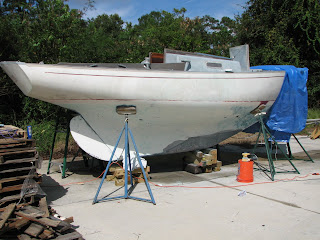


I have concluded the sanding of the bottom, from the boot stripe to and including the keel, and am about ready to begin fairing the hull. I do have yet to sand the portion of the hull currently hidden behind the jack stand pads, but that will be a quick job. I do have some questions regarding the small gelcoat blisters that had formed, and now, through sanding , are breaking loose and leaving very small circular voids that are roughly the depth of the gelcoat. My thoughts are to: (1) grind around these areas to remove the cracking and pitting areas, (2) wipe down with acetone, (3) brush on a layer of neat epoxy with a high-density foam roller, (4) apply thickened epoxy (West System 407) for filling and sanding (repeat if necessary), (5) apply a couple more coats of neat epoxy for West System 422 additive for a barrier coating, then (6) apply bottom paint.
If anyone has any recommendations, then I would love to review them...so, please take a moment and provide me with your comments.
Fortunately there are no major dings in the hull that need to be dealt with; however, I will be replacing
the through hull fittings, and will likely glass over the old holes to start fresh with new fittings.
Stay tuned...
No comments:
Post a Comment